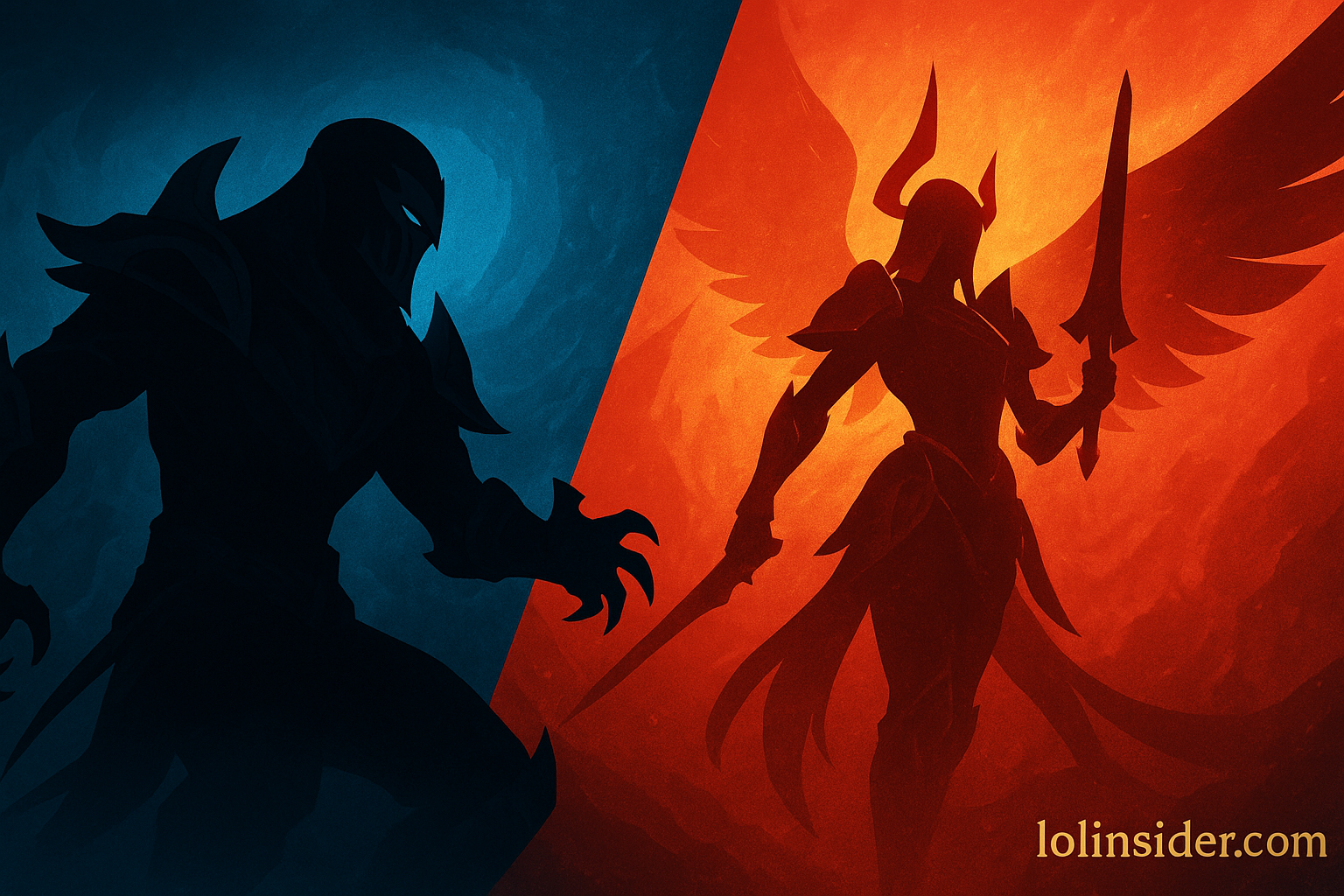In League of Legends, timing is everything. Understanding Early Game vs Late Game Champions is one of the most important concepts for climbing the ranked ladder. Whether you’re dominating lane as Draven at minute five or scaling patiently as Kassadin until level sixteen, the outcome of most matches depends on how well you understand power spikes, tempo, and win conditions over time.
In this in-depth guide, we’ll break down exactly what makes a champion strong early or late, why scaling differs, how to adjust your strategy, and how to make the most of your champion’s strengths at every stage of the game.
1. What Does Early Game vs Late Game Mean?
The terms early game and late game refer to different phases of a League of Legends match, each defined by the average power level of champions and available objectives.
- Early Game (0–15 minutes):
Focused on laning, early skirmishes, and setting up vision or objectives like the first Dragon or Rift Herald. Early game champions thrive in this phase because their kits are strong with few items or levels. - Mid Game (15–25 minutes):
A transition period where small team fights and rotations start happening. Teams contest towers, vision, and second objectives. Many champions hit their first or second item spike here. - Late Game (25+ minutes):
A stage where scaling champions shine. Full builds, level 16–18, and Elder/Baron fights dominate the map. Mechanical mistakes matter less than one good engage or one pick.
When comparing Early Game vs Late Game Champions, we’re essentially comparing who has the upper hand during these stages and how that affects the overall strategy.
2. What Makes a Champion “Early Game”?
An early game champion is designed to dominate before opponents scale. They rely on strong laning, snowball potential, and early item spikes.
Traits of Early Game Champions:
- Strong base stats or early damage ratios
- Short cooldowns or high burst early
- Strong 1v1 or 2v2 potential
- Reliance on early leads to stay relevant
Examples:
- Zed: Can kill most mages by level 6.
- Lucian: Strongest in early trades with double-shot passive and low cooldowns.
- Renekton: Excellent at early lane dominance, falls off later.
- Lee Sin: High mobility, pressure jungler who loses value past 25 minutes.
- Draven: Massive early-game damage, needs snowball gold advantage.
Why Early Game Matters:
If your champion spikes early, your job is to push the tempo — force fights, take objectives, and deny scaling champions the chance to reach their power peaks.
3. What Makes a Champion “Late Game”?
Late game champions are designed to scale — they might start weak, but as the game goes on, they become unstoppable. Their abilities, ratios, and item synergies improve dramatically over time.
Traits of Late Game Champions:
- Weak laning but strong scaling ratios
- Reliant on gold, XP, and items
- Teamfight monsters once scaled
- Thrive in coordinated late-game fights
Examples:
- Kayle: Weak pre-level 11, godlike after level 16.
- Veigar: Infinite scaling AP, lethal one-shots in late game.
- Kassadin: Vulnerable early, unkillable after level 16.
- Vayne: Short range early but insane late-game DPS.
- Senna: Grows infinitely stronger through souls.
Why Late Game Exists:
Late-game champions give your team win conditions. Even if you fall behind early, you can win if you stall long enough for your late-game carries to peak.
4. The Science of Power Spikes
Every champion has power spikes — moments in the game where they hit a new level of strength due to items, levels, or ability upgrades.
Types of Power Spikes:
- Level Spikes:
- Level 2 (early aggression): e.g., Renekton, Lucian
- Level 6 (ultimate unlock): e.g., Zed, Nocturne, Malphite
- Level 11–16 (ultimate upgrades): e.g., Kayle, Kassadin
- Item Spikes:
- First item (Luden’s, Eclipse, Divine Sunderer)
- Two-item power spikes (e.g., Ezreal with Manamune + Essence Reaver)
- Full build spikes (e.g., Vayne or Jinx at six items)
- Team Spikes:
- Some comps spike together.
- Example: Elise + Renekton early dive comp.
- Example: Ornn + Jinx scaling comp late.
- Some comps spike together.
Understanding your champion’s spikes lets you plan your gameplay — when to fight, when to avoid, and when to secure objectives.
5. How to Play Early Game Champions Effectively
If you’re playing a champion like Lee Sin, Zed, or Draven, your mission is clear: win before 25 minutes.
Key Strategies:
- Pressure early objectives:
Take first dragon, invade enemy jungle, or force Herald at 8:00. - Snowball lanes:
Use strong laners to push leads. Coordinate dives and invade with vision control. - Force tempo:
Never give scaling comps breathing room. Keep rotating and forcing plays. - End efficiently:
Don’t overchase kills. Secure Baron or inhibs and close the game.
Common Mistakes:
- Wasting early lead chasing kills
- Failing to use tempo to secure towers
- Not converting picks into objectives
Pro Tip: Every minute that passes without advantage is time stolen by late-game champions.
6. How to Play Late Game Champions Effectively
If you’re piloting a Kassadin, Vayne, or Kayle, patience is your strongest weapon.
Key Strategies:
- Survive early:
Focus on CS, safe farming, and minimizing deaths. - Play around power spikes:
Identify when you hit key levels or items and start playing more aggressively then. - Trust your scaling:
You don’t need early kills. You just need gold and experience. - Teamfight positioning:
Your job is to stay alive and deal consistent damage when your team frontlines.
Common Mistakes:
- Overextending early without power
- Forcing fights before spikes
- Not communicating scaling win condition
Pro Tip: Your champion doesn’t need to “win” early – just don’t lose early.
7. Jungle and Objective Influence
The jungler plays a critical role in deciding whether the game follows an early or late tempo.
If You Have an Early Game Jungler (e.g., Elise, Rek’Sai, Lee Sin):
- Look to gank early and snowball lanes.
- Secure Heralds to open towers.
- Punish late-game junglers (like Kayn or Karthus) before they scale.
If You Have a Late Game Jungler (e.g., Karthus, Master Yi, Evelynn):
- Focus on power farming.
- Avoid early fights unless guaranteed.
- Scale up and look for picks once items are online.
Objective Control Example:
- Early comp → prioritize Heralds (map control & tempo).
- Late comp → prioritize Drakes (stacking win condition).
8. Lane Matchups and Wave Management
Wave control determines how you dictate tempo.
Early Game Champs:
- Push waves to deny CS and roam.
- Force enemy under tower.
- Dive with jungler pressure.
Late Game Champs:
- Use slow push to farm safely.
- Avoid extended trades early.
- Use wave resets to recall efficiently.
Understanding wave states lets you align with your power spikes and avoid unnecessary fights.
9. Team Composition Synergy
Winning drafts often come down to early vs late balance.
All-Early Game Comp Example:
- Top: Renekton
- Jungle: Lee Sin
- Mid: Syndra
- ADC: Draven
- Support: Nautilus
This comp aims to end fast. If it goes beyond 30 minutes, you lose scaling.
All-Late Game Comp Example:
- Top: Kayle
- Jungle: Karthus
- Mid: Kassadin
- ADC: Jinx
- Support: Lulu
Weak early, but nearly unbeatable late.
Balanced Comp Example:
- Early pressure jungle + scaling carry (e.g., Vi + Jinx)
- This gives flexibility depending on how the game evolves.
10. Vision Control and Tempo Management
Tempo and vision are often the deciding factors between early and late game success.
- Early game teams: Use deep vision and pink wards to control jungle entry points.
- Late game teams: Focus on defensive vision to protect farming routes.
- Mid game transition: Fight for river vision to secure dragons and barons safely.
Without vision, your comp’s identity crumbles — early game champs can’t force, late game champs can’t farm safely.
11. Adapting Playstyle by Role
Each role contributes differently to early or late-game strategy.
Top Lane:
- Early: Play aggressive duelists like Renekton or Darius.
- Late: Scale with picks like Ornn or Kayle.
Jungle:
- Early: Path to pressure lanes.
- Late: Farm and scale safely (Karthus, Evelynn).
Mid Lane:
- Early: Roamers like Talon or Zed.
- Late: Scaling mages like Veigar or Kassadin.
ADC:
- Early: Lane bullies (Lucian, Draven).
- Late: Hypercarries (Vayne, Jinx).
Support:
- Early: Engage and roam (Leona, Nautilus).
- Late: Peel and buff (Lulu, Janna).
12. How to Draft Smartly Around Early and Late Power
When drafting in ranked or competitive play, mix your team’s power curve:
- Pair early jungler with scaling mid or ADC.
- Avoid 5 scaling champs — no pressure early.
- Avoid 5 early champs — no fallback plan if game extends.
Pro Tip: Think of your draft as a timeline. You want strong moments at every 10-minute interval.
13. Early Game vs Late Game in Competitive Meta
The competitive meta shifts constantly — some patches favor early aggression, others reward scaling comps.
When Early Game Dominates (e.g., Patch 15.1–15.3):
- Fast-paced junglers strong
- Early objective gold high
- Games end around 25–28 minutes
When Late Game Dominates:
- Scaling items (like Infinity Edge or Rabadon’s) become more efficient
- Tanks and enchanters buffed
- Fewer snowball mechanics
Understanding the patch meta helps you decide which style to prioritize.
14. Famous Early vs Late Game Duels
Let’s explore some iconic champion matchups illustrating this concept:
| Matchup | Early Game Winner | Late Game Winner |
|---|---|---|
| Zed vs Kassadin | Zed (kill pressure early) | Kassadin (unbeatable late) |
| Draven vs Vayne | Draven | Vayne |
| Renekton vs Kayle | Renekton | Kayle |
| Elise vs Karthus | Elise | Karthus |
| Lucian vs Jinx | Lucian | Jinx |
Each matchup tells a story: whoever dictates tempo wins.
15. Mentality and Communication
Even the best draft can fail if your team doesn’t understand its win condition.
- Playing early comp? Ping timers, force objectives, and end fast.
- Playing late comp? Tell your team to stall, don’t overforce, and scale patiently.
Communication aligns your team’s mindset with your comp’s strengths.
16. Key Takeaways
- Early Game Champions = pressure, snowball, tempo.
- Late Game Champions = patience, scaling, teamfights.
- Power spikes decide when to fight.
- Tempo and vision amplify your comp’s strengths.
- Draft balance ensures long-term flexibility.
Mastering Early Game vs Late Game Champions isn’t just about knowing who wins when — it’s about understanding timing, adapting strategy, and executing your win condition better than the enemy team.
17. FAQs
Q1: Can an early game champion win late game?
Yes — if they snowball hard enough early or end before the enemy scales. A 10k gold lead can overcome scaling differences.
Q2: Are hybrid champions possible?
Absolutely. Some champions like Camille, Akali, or Ezreal scale decently but also have strong early spikes.
Q3: What’s the best strategy if both teams scale?
Focus on macro — split push, secure objectives, and limit mistakes. One teamfight or Baron can decide the match.
18. Conclusion
In League of Legends, every match is a race against time — Early Game vs Late Game Champions defines how that race unfolds. Early champions sprint fast but tire quickly, while late-game champions start slow and become unstoppable machines.
The secret to mastering both styles lies in understanding when your power spikes, how to exploit or avoid fights, and how to play for your win condition.
Whether you’re the Zed crushing lane at 10 minutes or the Kayle carrying at 40, success comes down to timing, communication, and strategic execution.







